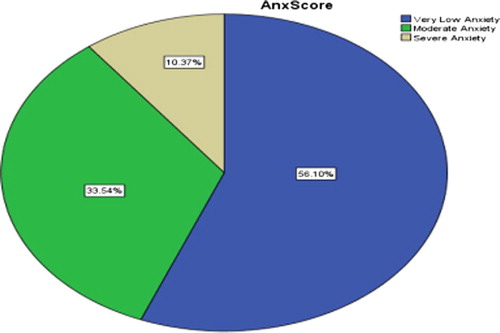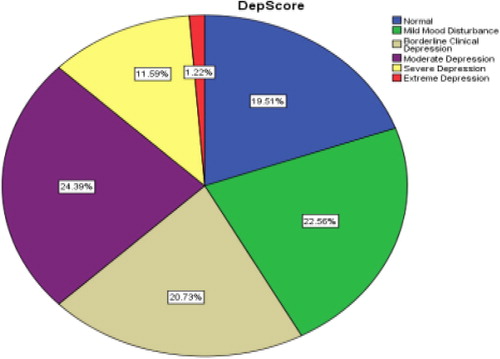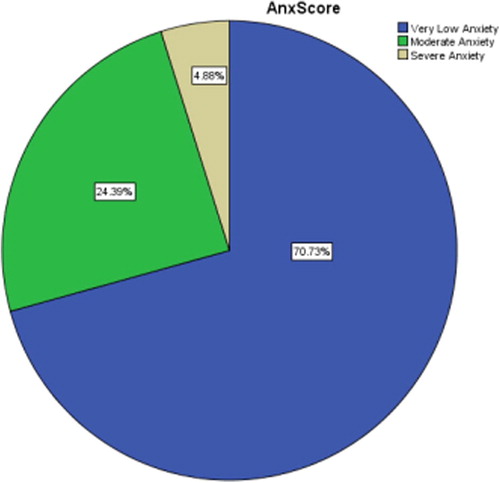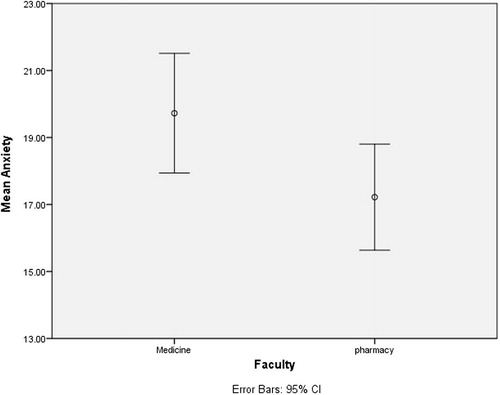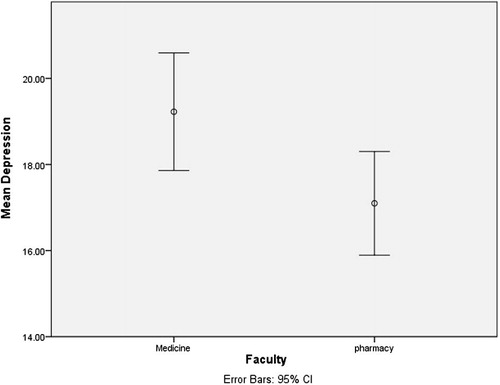Abstract
Introduction
Depression and anxiety in the community are considered as specific indicator for mental status of a person and various studies have documented anxiety and depression among medical and pharmaceutical students.
Objective
In this study, the prevalence of anxiety and depression was measured among medical and pharmaceutical students in the Alexandria University.
Methods
Students from both faculties were asked to complete both Beck depression inventory and Beck anxiety inventory.
Results
In Faculty of Medicine, with total number of 164 students, the prevalence of anxiety and depression was found to be 43.9% and 57.9%, respectively, based on the cut-off points of both questionnaires.
In Faculty of Pharmacy, with total number of 164 students, the prevalence of anxiety and depression was found to be 29.3% and 51.1% respectively, based on the cut-off points of both questionnaires.
Conclusion
The study revealed significant distress among both medical and pharmaceutical students. Moreover, it was concluded that the prevalence of anxiety and depression in Faculty of Medicine was found higher than that in Faculty of Pharmacy. Furthermore, it was noticed that the prevalence of symptoms was higher among females.
KEYWORDS:
1 Introduction
Anxiety and depression are worldwide problems which reflect the mental health of the population. A lot of researches reported anxiety and depression among medical students specially in their first academic year as they are going to suffer from academic stressors such as information input overload, lack of leisure time and academic evaluation (exams and continuous assessments), for many students depression stimulates feeling of fright, lack of ability, anger and can be associated with psychological and physical morbidities.Citation1,Citation2
Table 1 Distribution of medical students studied according to age, sex, anxiety and depression levels.
Table 2 Distribution of pharmaceutical students studied according to age, sex, anxiety and depression levels.
Table 3 Summarizing table showing the distribution of studied students according to age, sex, anxiety and depression levels for each faculty.
Table 4 Comparing mean and standard deviation of age, anxiety score and depression score for each faculty.
Table 5 Comparing the anxiety and depression levels between male and female of each faculty.
Increase in levels of anxiety and depressionCitation3–Citation4Citation5 may have a negative effect on proficiency of academic study program, courses suggested by schools such as (deteriorating clinical practice and stress induced disorders)Citation6 plus it will affect the society economicallyCitation7,Citation8 in addition patients care is affected by psychological distress among physicians such as (Poor communication, diminished quality of care and medical errors have been found to be associated with physical stress).Citation9,Citation10
Gender differences in anxiety and depression have been found in both practicing and newly qualified physicians, which mirrors epidemiological studies indicating that depression is more common among women than men.Citation17 Most, but not all, studies conducted among medical students, using various instruments, show a similar pattern.Citation12–Citation13Citation14Citation15
The prevailing view is that anxiety and depression rise during undergraduate medical education and this rise is more pronounced among women.Citation16–Citation17Citation18
Our purposes in this study are:
| (a) | Describing the prevalence of anxiety and depression among first year medical students in Faculty of Medicine and Faculty of Pharmacy in the Alexandria University. | ||||
| (b) | Comparing prevalence of both anxiety and depression among both faculties. | ||||
| (c) | Comparing gender differences of both anxiety and depression among a representative sample of both faculties in the Alexandria University. | ||||
| (d) | Comparing our findings with other studies either in the Middle East or in the western countries. | ||||
This study may help in designing appropriate intervention strategies to enhance the learning abilities which will improve the patient care by achieving good communication, increasing quality of care and decreasing medical errors in addition to burden the costs paid by the society through anxiety and depression attenuation.
2 Materials and methods
2.1 Study population
The medical course at the Alexandria University, which is the main and only governmental university in Alexandria, consists of two components; the first one is the core science component, which is the first three years. During this period, students study core medical science, and the other one is the clinical component, the next three years. During this period, the curriculum focuses mainly on clinical subjects and skills. Around 1400 students, typically aged 18–19 years, enter Year 1.
While in Faculty of Pharmacy, the course comprises only 1 year core science (Year 1) and 4 years biomedical, pharmaceutical and clinical sciences.
A cross sectional study was conducted in Faculty of Medicine and pharmacy in the Alexandria University of Egypt, in March 2013, among the first academic year students, who had spent more than six months in their schools. This was after the mid-year vacation. These students were selected randomly.
2.2 Sample size determination
According to student affairs administration in each faculty, the total number of registered students in 2012/2013, in the first academic year was 1376 and 1454 of both sexes, in the Faculty of Medicine and pharmacy respectively.
Sample size was calculated using the G power 3.010 statistical tool. Previous studies revealed that prevalence of depression among medical students was moderate (about 25%). thus effect size was used as .3, alpha error was used as 0.05, power was used as 0.95 and degree of freedom was used as 1. The calculated sample size was 145. Thus in this study a number greater than 145 was used, in a part to overcome the sampling error (328 students).
2.3 Methods
The selected students were personally contacted, informed of the questionnaire, aims, advantages and disadvantages of the study, and asked to take part in the study. Confidentiality was ensured, and they were informed that their results will be sent to them through emails. All the students were contacted directly in and after the end of their classes. They were informed that filling in the questionnaire will not take more than fifteen minutes of their time. Filling in the questionnaire was completely optional for all the students. The study was held in the mid semester, to ensure that the students were not undergoing any stress related to final exams.
The twenty-one-item Beck anxiety inventory (BAI) and the twenty-one-item Beck depression inventory (BDI) were our tools to measure anxiety and depressive symptoms of the students. BAI and BDI were created by Dr. Aron T. Beck.Citation19,Citation20
Beck depression inventory (BDI) is a twenty-one-multiple-choice question self-report inventory. Each question has four possible answers. Each answer is given a score from zero to three, indicating how much the symptoms are severe. It is considered as one of the best used tools to assess depression and predict its severity. The questionnaire is best used for persons aged thirteen or more. BDI measures mood, pessimism, sense of failure, self-dissatisfaction, guilt, punishment, self-dislike, self-accusation, suicidal ideas, crying, irritability, social withdrawal, body image, work difficulties, insomnia, fatigue, appetite, weight loss, bodily preoccupation, and loss of libido. Items one to thirteen measure symptoms that are psychological in nature, while items fourteen to twenty-one measure more physical symptoms.
BDI scores were categorized into normal (1–10), mild mood disturbance (11–16), borderline clinical depression (17–20), moderate depression (21–30), severe depression (31–40) and extreme depression (more than 40).
Beck anxiety inventory (BAI) is a twenty-one-multiple-choice question self-report inventory. It measures common symptoms of anxiety (such as numbness and tingling, sweating not due to heat, and fear of the worst happening). The questionnaire is best used for persons between the ages from seventeen to eighty years. Each question has four possible answers like that of BDI. The questions are arranged in columns and the students were asked to mark against the appropriate answer.Citation20 The possible answers are: Not at all which takes 0 point, mildly (It did not bother me much) which takes 1 point, moderately (It was very unpleasant, but I could stand it) which takes 2 points, severely (I could barely stand it) which takes 3 points.
BAI-1 scores were categorized into very low anxiety (1–21), moderate anxiety (22–35) and severe anxiety (more than 36).
A paper published in 1999 stated that the BAI came third after both STAI and the Fear Survey Schedule as the most used measuring tool for anxiety.Citation19
According to the American thoracic society website BAI shows scoring test–retest reliability with a correlation over one week, r = 0.75, Scoring Internal consistency with a Cronbach’s alpha = 0.92 and Validity correlated with the modified Hamilton Anxiety Rating Scale; good discriminated validity.
BDI and BAI were given to the students in the Arabic version as it is the mother tongue in Egypt and to ensure that it was fully understood.Citation21,Citation22
The demographic variables included gender, age (18–20), major of study and year of study.
2.4 Data analysis
The collected data were analyzed using IBM SPSS version 20 program. For analysis purpose, sex, faculty, depression score and anxiety score were coded. Frequency tables and graphs (pie charts and bar charts) were generated. Mean and standard deviation values of age, depression score and anxiety score were calculated.
The cut-off score used for depression using BDI was 17 or more, while that of the anxiety using BAI was 22 or more.
3 Results
3.1 The distribution of studied medical students according to age, sex, anxiety and depression levels ()
In Faculty of Medicine a total number of 164 students participated.
According to their anxiety level it was found that, 92 (56.1%), 55 (33.5%) and 17 (10.4%) suffer from very low, moderate and severe anxiety states respectively. Based on the BAI questionnaire cut-off point, 72 (43.9%) students are suffering from anxiety ().
According to their depression level, it was found that 32 (19.5%) were within the normal level, while 37 (22.6%), 34 (20.7%), 40 (24.4%), 19 (11.6%) and 2 (1.2%) suffer from mild mood disturbance, borderline clinical depression, moderate, severe and extreme depressions respectively. Based on BDI questionnaire cut-off point, 95 (57.9%) suffer from depression ().
3.2 The distribution of studied pharmaceutical students according to age, sex, anxiety and depression levels ()
In Faculty of Pharmacy a total number of 164 students participated.
According to their anxiety level it was found that, 116 (70.7%), 40 (24.4%) and 8 (4.9%) suffer from very low, moderate and severe anxiety states respectively. Based on the BAI questionnaire cut-off point, 48 (29.3%) students are suffering from anxiety ().
According to their depression level, it was found that 32 (19.5%) were within the normal level, while 48 (29.3%), 33 (20.1%), 46 (28.0%) and 5 (3.0%) suffer from mild mood disturbance, borderline clinical depression, moderate and severe depressions respectively and there was no extreme level of depression. Based on BDI questionnaire cut-off point, 84 (51.1%) suffer from depression ().
3.3 Summarizing table showing the distribution of studied students according to age, sex, anxiety and depression levels for each faculty ()
From this table it was found that:
In Faculty of Medicine out of 164 students 89 (43.9%) students are suffering from anxiety while in Faculty of Pharmacy out of 164 students 48 (29.3%) students are suffering from anxiety according to the above mentioned cut off point.
It was also found that in Faculty of Medicine out of 164 students 95 (57.9%) suffer from depression while in Faculty of Pharmacy out of 164 students 84 (51.1%) suffer from depression according to the above mentioned cut-off point.
So it was concluded that both anxiety and depression levels in Faculty of Medicine were found higher than that in Faculty of Pharmacy.
3.4 Comparing mean and standard deviation of age, anxiety score and depression score for each faculty ()
and compare the mean values of the students of Faculty of Medicine and Faculty of Pharmacy according to their anxiety and depression scores.
3.5 Comparing the anxiety and depression levels between male and female of each faculty ()
In Faculty of Medicine, regarding anxiety according to the sex, 41.5% of male and 45.1% of female are suffering from anxiety, while in Faculty of Pharmacy, 13.6% of male and 43.3% of female are suffering from anxiety, based on the cut-off point of anxiety. Regarding depression, in Faculty of Medicine, 52.5% of male and 62.2% of female are suffering from depression, while in Faculty of Pharmacy, 50.7% of male and 50.6% of female are suffering from depression, based on the cut-off point of depression.
4 Discussion
Medical school has long been recognized as involving numerous stressors that can affect the well-being of students.Citation23 Anxiety and depression are worldwide problems which reflect the mental health of the population.Citation24 The mental status of medical and pharmaceutical students has been an important issue to be taken under consideration, reported in 1956,Citation25 as it is more liable to be affected by several stressors such as examining stress which will in turn lead to a series of consequences at both personal and professional levels. Several studies have reported significant distress among medical students.Citation28–Citation29Citation30Citation31Citation32 Contrarily, some studies have found little or no evidence of stress among medical students.Citation26,Citation27
In this research, among the medical students, 43.9% students are suffering from anxiety and 57.9% are suffering from depression. While in Faculty of Pharmacy, 29.3% students are suffering from anxiety and 51.1% are suffering from depression. Therefore, the study reveals significant distress among both medical and pharmaceutical students.
Moreover, it was concluded that the prevalence of anxiety in Faculty of Medicine (43.9%) was found higher than that in Faculty of Pharmacy (29.3%). Also, the prevalence of depression in Faculty of Medicine (57.9%) was found higher than that in Faculty of Pharmacy (51.1%). Several theories were explained in many researches. Some have contributed these findings to that medical students pass through continuous examinations throughout their academic years. Studying medicine is competitive. Several academic stressors were reported in many previous researches.Citation33 Pharmaceutical students pass through less number of examinations and much easier than those of the medical students. Others stated that medical students are liable to be critical of themselves. Moreover, medical students tend to be more socially isolated than other students of different faculties. Medical students may be influenced by all these factors more than pharmaceutical students.
Our study revealed that there are differences in anxiety and depressive symptoms between genders. The prevalence of the symptoms was higher among females. Different studies show similarity with our study in reporting higher levels of depression among females.Citation34,Citation35 This is possibly due to the fact that (1) females complain more about the high load of the curriculum, (2) they are more likely to report stress,Citation37 (3) females are more liable to over complaint about physical and psychological symptoms,Citation38 and (4) female faces less job opportunities than males in eastern countries. However, in our study, since the questionnaire was self-administered and anonymous, solutions could not be made to rule out the above mentioned factors. However, some research findings are contrary to our results, and found no differences in anxiety and depressive symptoms between genders.Citation39,Citation40 This may be because of the equality of rights and job opportunities between both genders.
5 Conclusion
The study reveals significant distress among both medical and pharmaceutical students. Moreover, it was concluded that the prevalence of anxiety and depression in Faculty of Medicine was found higher than that in Faculty of Pharmacy. Furthermore, it was noticed that the prevalence of symptoms was higher among females.
Medical students with anxiety and depression if identified early can be managed by behavioral therapy, emotional support, interpersonal psychotherapy, social skill training etc., this may help the young medicos to overcome their difficulties and lead a healthier life.
6 Limitations
In this study, some limitations should be considered. One of those limitations is possibility of biased sampling because samples were randomly selected from the University of Alexandria. Generalizing our results to all Egyptian medical students is hard. The second point is that family history of depression and stressful events was not taken into consideration. Further studies should take these limitations including genetic and environmental problems into consideration.
Lastly, not enough sample size was selected, so larger sample size should be considered in future studies.
Fund statement
The whole study was funded by the authors.
Conflict of interest
We have no conflict of interest to declare.
Acknowledgments
The authors thank Prof. Dr. Fathi El-Gamal (Professor of community department, Alexandria University) for his active supervision in this study.
Notes
Peer review under responsibility of Alexandria University Faculty of Medicine.
Available online 28 July 2014
References
- M.BostanciO.OzdelN.K.OguzhanogluL.OzdelA.ErginDepressive symptomatology among university students in Denizli, Turkey: prevalence and sociodemographic correlatesCroat Med461200596100
- T.EllerA.AluojaV.VasarM.VeldiSymptoms of anxiety and depression in Estonian medical students with sleep problemsDepress Anxiety2342006250256
- Ganesh S.KumarAnimeshJainSupriyaHegdePrevalence of depression and its associated factors using Beck depression inventory among students of a medical college in KarnatakaIndian J Psychiatry5432012223226
- Thelma A.QuinceDiana F.WoodRichard A.ParkerJohnBensonPrevalence persistence of depression among undergraduate medical students: a longitudinal study at one UK medical schoolBMJ242012e001519
- SurbhiSidanaJugalKishoreVidyaGhoshDivyanshGulatiR.C.JilohaTanuAnandPrevalence of depression in students of a medical college in New Delhi: a cross-sectional studyAustralas Med J552012247250
- R.C.KesslerE.E.WaltersEpidemiology of DSM-III-R major depression and minor depression among adolescents and young adults in the National Comorbidity SurveyDepress Anxiety711998314
- A.HysenbegasiS.L.HassC.R.RowlandThe impact of depression on the academic productivity of university studentsJ Ment Health Policy Econ832005145151
- P.SobockiB.JonssonJ.AngstC.RehnbergCost of depression in EuropeJ Ment Health Policy Econ9220068798
- P.SobockiI.LekanderF.BorgstromO.StromB.RunesonThe economic burden of depression in Sweden from 1997 to 2005Eur Psychiatry2232007146152
- J.Firth-CozensJ.GreenhalghDoctors’ perceptions of the links between stress and lowered clinical careSoc Sci Med44199710171022
- R.C.KesslerEpidemiology of women and depressionJ Affect Disord742003513
- L.N.DyrbyeM.R.ThomasT.D.ShanafeltSystematic review of depression, anxiety and other indicators of psychological distress among US and Canadian medical studentsAcad Med812006354373
- M.E.DahlinN.JoneborgB.RunesonStress and depression among medical students: a cross-sectional studyMed Educ392005594604
- C.T.SreeramareddyP.R.ShankarV.S.BinuPsychological morbidity, sources of stress and coping strategies among undergraduate medical students of NepalBMC Med Educ7200726
- S.MancevskaL.BozinovskaJ.TecceDepression, anxiety and substance use in medical students in the Republic of MacedoniaBratisl Lek Listy1092008568572
- Badria K.Al-DabalManal R.KouraRasheedParveenLatifaAl-SowielemSuhair M.MakkiA comparative study of perceived stress among Female Medical and Non-Medical University Students in Dammam, Saudi ArabiaSultan Qaboos Univ Med J1022010231240
- S.N.Bazmi InamAnxiety and depression among students of a Medical College in Saudi ArabiaInt J Health Sci (Qassim)122007295300
- A.T.BeckC.H.WardM.MendelsonJ.MockJ.ErbaughAn inventory for measuring depressionArch Gen Psychiatry41961561571
- A.T.BeckAn inventory for measuring clinical anxiety: psychometric propertiesJ Consult Clin Psychol5661988893897
- J.WestAn Arabic validation of a depression inventoryInt J Soc Psychiatry3141985282289
- lhsanAI-IssaAbdulgawiAI ZubaidiDonaldBakalS.TakFung Beck anxiety inventory symptoms in Arab college studentsArab J Psychiatry (AJP)1112000
- M.S.KhanS.F.MahmoudA.BadshahS.U.AliY.JamalPrevalence of depression, anxiety and their associated factors among medical students in Karachi, PakistanJ Pak Med Assoc562006583586
- R.E.MitchellJ.R.MathewsT.G.GrandyThe question of stress among first year medical studentsJ Med Educ581983367372
- G.SaslowPsychiatric problems of medical studentsJ Med Educ3119562733
- R.F.VazE.F.MbajiorguS.W.AcudaA preliminary study of stress levels among first year medical students at the University of ZimbabweCent Afr J Med441998214219
- J.A.BramnessT.C.FixdalP.VaglumEffect of medical school stress on the mental health of medical students in early and late clinical curriculumActa Psychiatr Scand841991340345
- D.C.ClarkP.B.ZeellowVicissitudes of depressed mood during four years of medical schoolJAMA260198825212528
- P.P.VitaliomoA biopsychosocial model of medical student distressJ Behav Med111988311313
- S.N.InamA.SaqibE.AlanPrevalence of anxiety and depression among medical students of a private universityJ Pak Med Assoc5320034447
- J.DaviliaC.HammenD.BurgeB.PaleyS.DaleyPoor interpersonal problem solving as a mechanism of stress generation in depression among adolescent womenJ Abnorm Psychol1041995592600
- R.J.LamerineChild and adolescent depressionJ Sch Health651995390393
- R.MikolajczykA.MaxwellW.El AnsariV.NaydenovaC.StockPrevalence of depressive symptoms in university students from Germany, Denmark, Poland and BulgariaSoc Psychiatry Psychiatr Epidemiol4322008105112
- D.L.FrankoR.H.Striegel-MooreJ.BeanB.A.BartonF.BiroSelf-reported symptoms of depression in late adolescence to early adulthood: a comparison of African-American and Caucasian femalesJ Adolesc Health3762005526529
- T.J.WadeJ.CairneyD.J.PevalinEmergence of gender differences in depression during adolescence: national panel results from three countriesJ Am Acad Child Adolesc Psychiatry4122002190198
- L.M.VerbueggeGender and health: an update on hypothesis and evidenceJ Health Soc Behav261985156182
- M.BostanciO.OzdelN.K.OguzhanogluL.OzdelA.ErginDepressive symptomatology among university students in Denizli, Turkey: prevalence and sociodemographic correlatesCroat Med J461200596100
- N.BayramN.BilgelThe prevalence and socio-demographic correlations of depression, anxiety and stress among a group of university studentsSoc Psychiatry Psychiatr Epidemiol4382008667672
- K.GrantP.MarshG.SyniarM.WilliamsE.AddlespergerGender differences in rates of depression among undergraduates: measurement mattersJ Adolesc2562002613617

